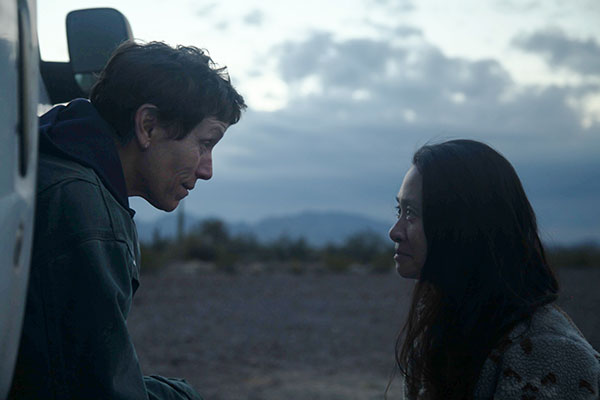
Robert Buck
Dedicated to the ones who had to depart. – Nomadland, Chloé Zhao
Cinema is not spectacle, it is writing. – Notes on Cinematography, Robert Bresson
Such is the exploit of calligraphy (…) to figure in one stroke the unary One as a character (…) Between center and absence, between knowledge and jouissance, there lies the littoral that only fetches to the literal provided that you are able to take this very same bend at all times. It alone allows you to hold yourself to be the agent that supports it. – Lituraterre, Jacques Lacan
Nomadland is a 2020 film by Chloé Zhao starring Frances McDormand as a woman, Fern. She and her husband Beau lived and worked in Empire, Nevada, a company-mining town. Following Beau’s death and the later 2011 economic collapse of the town in the wake of the Great Recession, she departs. Empire today is a ghost town. Fern lives in her van traveling the American West in search of seasonal labor. Zhoa makes narrative films using documentary procedures. In Nomadland, her third film, she interlaces Fern’s fictional quest with factual ones recounted in the 2017 non-fiction book by Jessica Bruder, Nomadland: Surviving America in the Twenty-First Century. She situates a professional actor, Frances McDormand, Fern, among non-professional ones cast from Bruder’s book. During the four-month shoot in the fall of 2018, Zhao and McDormand lived and worked out of their vans, which they each named, Akira and Vanguard, respectively. The path of annual gig work Fern and Zhao’s production take is as follows: CamperForce worker at an Amazon fulfillment center in Southern California before the Christmas holidays; stockperson at a rock and gem show, Quartzsite, Arizona, February; Badlands National Park camp host and Wall Drug waitress, Wall, both in South Dakota, summertime; and a beet harvester, Nebraska, in the fall.
Nomadland is Zhao’s cinematographic chronicle of Fern’s meandering, to the letter. Zhao renders her character’s gradual assumption of her singularity as an episodic series of poetic, often tender scenes. Fern is portrayed, remarkably so, as passing from a solitary to One all alone. Her odyssey, that is, Zhao’s film, begins with an instant of seeing as being seen. When Fern lifts the gate of her Empire storage locker, Zhao’s camera, placed inside the unit, captures Fern outside. This double-sided in here/out there Möbian topology structures the production, apart of while apart from documentary, the narrative, a figure-8, and the character’s migration in it. Having opened the eye of the camera, as it were, its presence will inform the action of the film as Fern’s sole and omniscient traveling companion.
Dave, a fellow itinerant worker (and one of two additional professional actors in the film), approaches Fern at a camp junk-swap. About the inevitability of losing things he says, “There’s a black hole in every van,” to which Fern replies, “That doesn’t happen to me.” When a Badlands tourist asks about her wedding ring, “Are you married?,” Fern answers with a grin, “I am, but my husband died … I’m not gonna take that off.” She doesn’t lose or abandon things. There are no holes. Before moving on, Dave leaves Fern a rock, pitted with holes, and a note, “If you come to visit there’s more of these.” He means the rock. She notes the holes. Looking through one, Fern pans the landscape, left to right. Traffic is passing on a highway in the distance. The hole is her viewfinder, the shot her point-of-view. Fern-the-character, nomad, sees what Zhao-the-cinematographer does, land, horizon. On the move, watching it move, she is out there. Through this ‘stereoscopic’ rock hole/camera lens frame, nomad and land coalesce; Fern’s fiction and Zhao’s film converge. The double inscription literalizes the new logic of the title neologism nomadland, place of movement/movement as place. When Vanguard breaks down Fern visits her sister Dolly to borrow money. The sisters talk. Dolly places the signifier out there in a series that links Fern’s peripatetic life, the puzzling nature of her marriage and her eccentricity as a girl. In this moment, out there is grasped by Fern – as if it is in here. Thus when Dolly adds, “You left a a big hole by leaving,” Fern, having accepted responsibility for her jouissance, replies, “That one’s on me.”
Zhao devotes passages to Fern executing chores she’s learned to do during her various jobs. While the scenes depict menial labor they infer her learning otherwise, a know-how. During her journey, Fern twice encounters a young train-hopper. When she recites to him her wedding vow, a Shakespeare sonnet, and then watches him go, the drift is her departure from Beau. This elegy continues to Fern in Vanguard looking through a slide-viewer at images of herself as a child, which Zhao films as Fern’s point-of-view. As a re-inscription of her sister’s words and the ‘stereoscopic’ frame, Fern apperceives out there from the extimate place she now occupies, out there. Later, with Zhao’s camera at her side, she wanders alone through a forest of monumental redwood trees. She is on her way to visit Dave’s family in Mendocino via the California coastal highway. Cinematographically throughout the film, Zhao cuts the confines of contemporary life, both home and work, in here, against the limitlessness of land and the open road, out there. Unable to sleep in the family’s home, Fern repairs to Vanguard for the night. At dawn she walks alone through the house, scanning furnishings, possessions, objects. The scene evokes two times, her past life with Beau, a future one with Dave. She departs again. She meanders along the serpentine cliff above a turbulent Pacific ocean. Zhao’s camera traces a gull in flight. Fern is fully alive. Cut.
She returns to Amazon, where the seasonal cycle of gig work begins again. Later, in Quartzsite, Fern reflects on life after Beau with the leader of the annual nomadic gathering there: "If I didn’t stay, if I left, it would be like he never existed. I couldn’t pack up and move on. He loved Empire. So I stayed. Same town. Same house. It’s like my dad used to say, 'What’s remembered lives.' I maybe spent too much of my life remembering. You know what I mean?" When he misses her meaning, of not living herself, she encounters solitude again, this time implicitly as a woman. In the following scene, camp participants toss rocks into a fire for a deceased friend. In effect, the memorial is for Fern. She too liked rocks. She too has ‘departed’ –– her previous life, common-sense, identifications.
In the New Year, along the band where she and Zhao’s film began, Fern returns to her storage unit to empty it. Asked if she needs any of her belongings, she says, “I’m not gonna miss one thing,” which can be heard as her traveling companion, Zhao’s camera. Afterwards, she revisits the abandoned company mine, walks the street where she lived at the margin of town and returns to the tract house she shared with Beau. But the bow came undone; out there will enable her to knot it differently. She stands at the kitchen sink looking through the window at the breathtaking view she had day-in day-out. “Our backyard looked out at this huge open space, desert, desert, desert… all the way to the mountains. There was nothing in our way.” Unobstructed, lacking nothing, she walks away from the camera through the backdoor past a fence off screen into out there. The slow zoom-in past the yard to the mountains is replaced a beat later by a traveling shot of another snow-capped mountain range. With the very same cursive cinematographic inscription as in earlier iterations of the roadway scene, pan left to right, land to nomad, Zhao’s camera relocates Fern taking the very same bend ahead of her along a winding road. Camera movement and van trajectory occur simultaneously. “Two temporal moments are marked out therein” (Lituraterre). Striking out this time she strikes out what had been striking her out. Out there moving alone along a road, camera in tow, her realization of her singularity is captured. She can weather life as a nomad. With this iteration the littoral fetches to the literal and Fern’s fiction and Zhao’s film conclude.
Counting myself as three, the places where I allowed myself to be traversed by Zhao’s film and Fern: St. Augustine, Florida; Atlanta, Georgia; New York, New York; El Paso, Texas; Marfa, Texas; the Solitario, near the ghost town of Terlingua, Texas, on the US/Mexico border; and back to Atlanta, Georgia, June 1, 2021, 6:36pm ET, 80°
Robert Buck © 2021
Download
.png)


